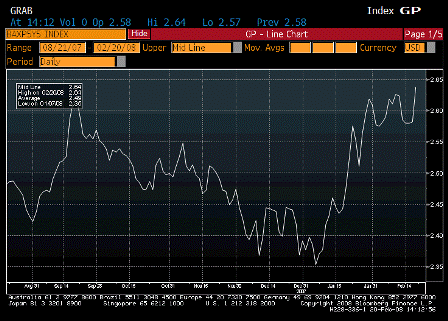(some email q&a’s)
UPDATED as more questions come in!!
Why would shareholders approve this sale?
Answer, they may not. They may take their chances with getting more $ in bankruptcy.
Or a higher bid might surface.
The Fed has turned Bear Stearns into a ‘free call’ with their non recourse financing,
And the Fed has moved spreads of agency and AAA paper back towards ‘fair value’ with their openended funding lines. This removes ‘liquidity risk’ and allows the securities to return to being priced on ‘default risk.’
This has dramatically increased the business value of Bear Stearns.
The large shareholders can now say no to the sale, maybe add a bit of capital or take on a ‘business partner,’ and outbid JPM for the remaining shares (if needed).
Might even start a bidding war.
There could still be well over $60 per share of value for the winner.
And there’s a reasonable amount of time for them to put something together.
And maybe this was Bear’s plan all along.
They knew they needed Fed funding to maximize shareholder value, and the JPM involvement to stabilize their client base and buy the time to find a real bid.
(CNBC now showing a chart showing $7.7 billion in breakup value.)
Seth writes:
For 2 a share is Chase getting a boat load of non prime paper that over time is worth a lot more than 2?
From what I’m hearing it’s already worth maybe 75 or more.
And the Fed gave jpm a free call.
The $2 is the least that it’s worth, as the fed is providing non recourse funding for the assets at prices that support the $2 price.
And at the same time the Fed took action to restore pricing of agency and aaa assets to more accurately reflect their actual default risk, which is near 0.
This is different.In this case the moral hazard is in not funding the primary dealers.It’s too easy for the predators (other dealers, hedge funds, etc.) to first get short the stock and then start a run on any broker that has to have any non tsy inventory financed and drive them out of business.
By funding the primary dealers who are in good standing (they report their finances to the fed) and regulating capital requirements and haircuts predators are kept at bay and shareholders continue to assume the business risk of the primary dealers.
Steve writes:
And the Fed has said in times of crisis they will not punish the many for the few.
Moral hazard is not a fixed doctrine. It requires flexibility and in times of crisis they accept that their action (the Fed’s) will not address the doctrine. On balance it is a price (overlooking moral hazard) they must pay for the greater good.
They have done it in the past so doing it again reflects a degree of consistency not a change in policy.
Paul writes:
How do you respond to the moral hazard argument of the Fed bailing out Bear Stearns?
I’ll let the word ‘bailout’ go for now, and begin by saying the liability side of banking is not the place for market discipline, and it’s also probably not the place for market discipline for the Fed’s appointed (anointed?) ‘primary dealers.’
(I will also not here question the idea of having primary dealers in the first place, but don’t take that mean i approve of that setup, thanks!)
So given the Fed wants primary dealers, it then follows there are specific securities they go along with this assigned role.
Presumably those would include the likes of tsy secs, maybe agency paper, maybe AAA rated mtg backed securities, etc.
Presumably also are functions the Fed wants its primary dealers to perform, like being market makers, providing some notion of liquidity, etc. etc.
And, presumably, the Fed has some notion of public purpose behind this entire creation.
So, given all that, to support this ‘institution of public purpose,’ it behooves the Fed to ensure the primary dealers themselves have the available lines of credit to perform this vital public function (almost hurts to write that…).
The bank primary dealers do have ‘guaranteed liquidity’ and so are safely able to function as primary dealers, knowing they can always finance their inventory positions. This can be done via raising fed ensured bank deposits, and borrowing from the fed by using their inventory as collateral, etc.
The non banks were at a disadvantage to the banks in that they relied on the banks to fund their inventories.
Bear Stearns got shut down when the banks said ‘no’ for non credit related reasons. Bear had perfectly good collateral that they held as part of their primary dealer function (as defined by the govt regulations), and the banks said no, perhaps because they had their own internal issues.
The same would happen to the banks, and the entire economy, if the Fed simply said no to the banking system and one morning and didn’t open the payments system.
It’s just one of countless flaws in the institutional structure that doesn’t get noticed until it’s a problem, no matter how many times I’ve pointed it out to ‘authorities.’
So to your question, while I do see a lot of other moral hazard issues, I don’t see this as one of them.
The Fed simply told JPM to deal with Bear in the normal course of business and lend vs qualifying collateral as has always been the case, and as is the case when the Fed lends to JPM.
Let me know if I’m missing something, thanks!

